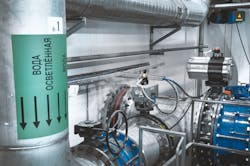About the author: Craig Correia is process automation industry manager for Festo. Correia can be reached at [email protected] or 508.380.4673.
From the time of its foundation more than 300 years ago, St. Petersburg, Russia, has set standards in architecture and city planning. Now the city is playing a role in the field of drinking water treatment in the largest country in the world.
The most northerly city in the world with a population of a million or more has resolved to implement a program to increase the energy efficiency of the drinking water supply for its southern areas. For this purpose, St. Petersburg has invested about 65 million euros over a period of three years. In addition to modernizing of 34 pumping stations, Vodokanal, St. Petersburg’s water utility, has set a goal of reducing the electricity consumption of the drinking water supply system by more than a third.
Energy-Efficient Pneumatics
Until now, electric drives were the first choice for Russia’s water treatment plants for opening and closing the inlets and outlets of sand-bed filters or in pumping stations. In St. Petersburg, the use of only electric drives would have meant an installed load of 75 kW for Vodokanal’s water treatment plant. The plant could not have provided this without extending the electrical infrastructure. “In order to achieve the energy-saving targets which we had set ourselves, we need to find new solutions,” said Maksim Pirschin, manager of the block K-6 of Vodokanal’s water treatment plant.
“During a visit to the IFAT trade fair in Germany, Vodokanal engineers became aware of the energy-efficient solutions with pneumatic actuators offered by Festo,” said Dr. Ivan Znamensky, Festo sales manager for the European part of Russia. A pneumatic system with actuators DAPS, including two air compressors, required an installed load of only 10 kW.
“Simply by replacing the electric drives with 120 pneumatic actuators, we were able to save at least an additional 65,000 euros,” Pirschin said.
Ready-to-Install Solutions
The new block K-6 of St. Petersburg’s Surface Water Treatment Plant includes 20 new sand-bed filters. Each filter basin is assigned six butterfly valves with actuators and shutoff valves to open and close the inlets and outlets.
In addition to valve assemblies consisting of butterfly valves with actuators, shutoff valves and sensor boxes—which Festo supplied in ready-to-install form—Vodokanal chose ready-to-install control cabinets with VTSA valve terminals, pressure and flow sensors, and service units from the company’s MS Series. “If we source all the pneumatic automation equipment which we need from the same supplier, we simply have fewer problems during operation and maintenance because Festo’s experts are always there when we need them,” Pirschin said.
The new block K-6 of the water treatment plant is equipped with a central control system at the process management level that allows comprehensive monitoring of the water treatment process. The control system gathers current data and compares it continuously with defined setpoints. The automation technology is fully integrated into this monitoring process and uses sensor signals to supply up-to-date information on the operating status of individual plant sections.
Water for a Boomtown
St. Petersburg and Moscow are Russia’s two boomtowns. St. Petersburg is still growing, with constant new housing developments and industrial zones. Vodokanal supplies 4.8 million people with 1.9 million cu meters of drinking water each day. Block K-6 of the waterworks alone provides 350,000 cu meters of drinking water that conforms to the highest modern standards in regard to filter technology and chemical treatment with ozone. The pneumatic automation technology installed in block K-6 also allowed the water utility to achieve a quantum leap in energy efficiency.
Download: Here
